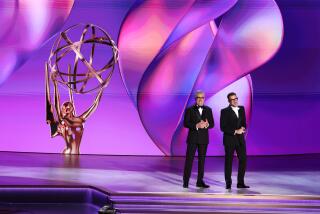John Cannon; Led N.Y.-Based National TV Academy
- Share via
John Cannon, president of the National Academy of Television Arts and Sciences in New York whose career began when the medium was in its infancy, died Friday of an apparent heart attack in Cologne, Germany.
“He was getting into a cab to visit one of the broadcast stations there, and he just dropped . . . a heart attack,” said Malachy G. Wienges, a former CBS executive who knew Cannon for more than 35 years. Cannon was in Germany making plans for a trip for the trustees of the academy, where he had served as president for the last 25 years.
Though Cannon’s exact age is unknown, he was thought to be in his mid-80s.
In 1977, the year after he was named chairman, the East and West Coast academies split after what was described at the time as a bitter rift over membership standards and voting procedures. Those on the West Coast had long murmured about ethical lapses in the voting process within the rival academy.
Since the mid-1980s, there has been intermittent talk about seeking to reconcile and reunite the two factions. Cannon was seen as an impediment to that process, and his death could lead to renewed discussions to merge the organizations.
In the split, the Academy of Television Arts and Sciences, based in North Hollywood, continued to present and oversee the prime-time Emmy Awards and Los Angeles-area Emmys.
The national academy orchestrates the Daytime Emmys and presents Emmys for sports, news and documentaries, and community service and public service announcements. That academy also represents 18 local chapters, from New York to San Diego and San Francisco, which recognize television excellence in those cities.
Amid criticism of and concerns regarding the administration of the Daytime Emmy voting, the West Coast academy joined with the New York academy to hand out and supervise those awards in 1984. However, speculation that their cooperation would lead to full reunification failed to materialize.
Meryl Marshall-Daniels, president of the Hollywood academy, remembered Cannon on Friday as someone who was “devoted to securing public recognition of the unique contributions of local television broadcasters throughout the country as well as around the world. “
Bob Levi, of worldwide program planning and acquisitions for Turner Broadcasting Systems, described Cannon as “a friend and a gentleman you could count on. I personally appreciated his touch to help heal the schism which was the divorce of the academies in 1977.”
Tom O’Neil, author of “The Emmys,” acknowledged that Cannon “was a controversial figure who could be considered stubborn, but on the other hand, he firmly championed the representation of non-Hollywood TV professionals.”
“His contribution is enormous,” said Paul Noble, national academytrustee and public relationship chairman. “His whole life was the Emmys.”
Wienges remembers Cannon’s dedication: “Every Sunday, he and [his wife] Trudy would take a taxi from their home in Queens to St. Patrick’s Cathedral. They’d go to Mass, then go to the TV academy and work until 4.”
Born in Chicago, Cannon attended Western Reserve University and received the Bronze Star during World War II. Before his presidency in 1976, he previously served as chair and vice chairman of the board of the academy. He was also president of the New York chapter for two years.
Involved in all aspects of TV production, as well as films and theater, Cannon was a performer and producer. Early in his career, Cannon, who was fluent in five languages, was chosen by the State Department as a narrator for presidential visits to foreign countries and reciprocal visits of foreign dignitaries to the United States. He was the voice of Fox Movietone News.
Times staff writer Greg Braxton contributed to this story.
More to Read
The complete guide to home viewing
Get Screen Gab for everything about the TV shows and streaming movies everyone’s talking about.
You may occasionally receive promotional content from the Los Angeles Times.







